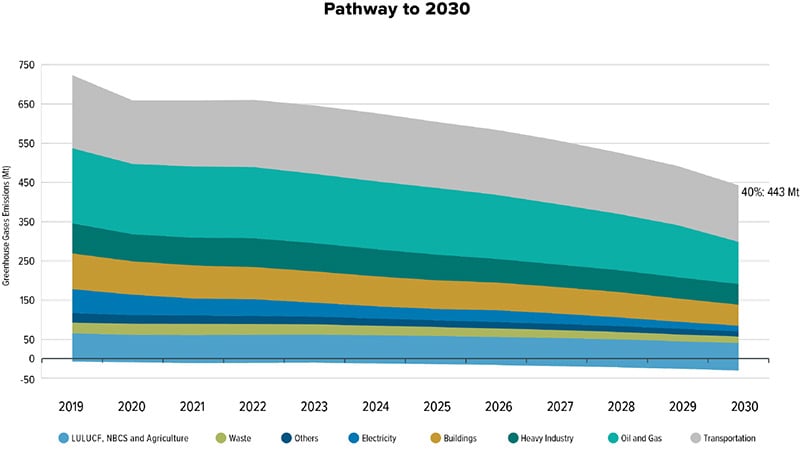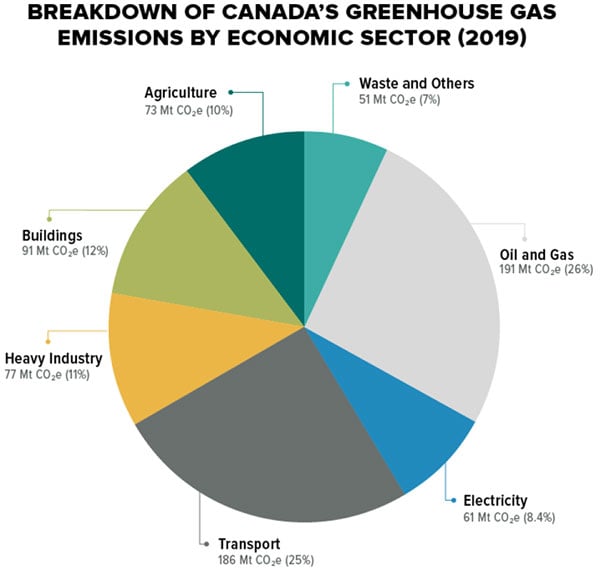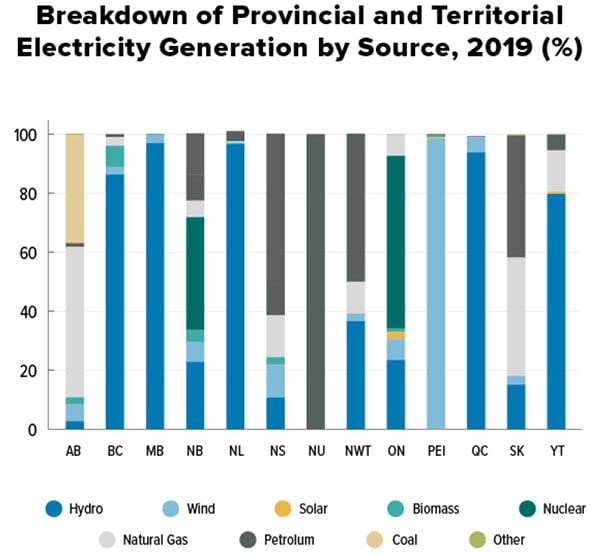What you need to know
- On March 29, 2022 the Government of Canada (Federal Government) delivered its 2030 Emissions Reduction Plan (the Plan);
- The Plan outlines current and new policies by the Government of Canada to meet its greenhouse gas (GHG) reduction targets and in some cases, associated funding.
- Key highlights include:
- Clean fuels: Accelerated year-to-year carbon intensity reductions are being proposed, including an annual reduction of 1.5 per cent carbon intensity instead of the previously planned 1.2 per cent annual reductions.
- Buildings: Regulation through building codes can help affect the changes needed to decarbonize the buildings sector, since much of the technology needed to achieve decarbonisation of the buildings already exists.
- Electricity: The electricity sector will be net-zero by 2035.
- Oil & Gas: The Government of Canada has expressed its commitment to cap and cut emissions from the oil and gas sector at a pace required to achieve net-zero by 2050, which caps are expected in Spring 2022.
- Transportation: Canada has reiterated that it will set gradually increasing annual targets for sales of passenger zero emissions vehicles by OEMs, culminating with a 100 per cent target by 2035.
- Sustainable finance: Canadian regulators are assessing current frameworks, and after extensive consultations, signalling new rules in the near future.
The below graph summarizes the planned emission reductions per sector targeted by the Federal Government.

Context
Canada’s international commitments
As signatory to the Paris Agreement, Canada has legally binding obligations to meet its stated emissions reduction targets. The national GHG reduction targets under the Paris Agreement are set out in a country’s nationally determined contributions (NDC), a document that must be submitted by all signatories. Canada updated its NDC in July 2021 ahead of COP 26 and shortly after the U.S. released their updated NDC.1 As a result, Canada’s current emissions reduction targets under the Paris Agreement equate to (i) 40 to 45 per cent below 2005 levels by 2030 (approximately 406.5 – 443.4 Mt CO2e), and (ii) net-zero emissions by 2050.
Each NDC outlines the sectors covered, the associated GHG emissions reduction targets and activities that will be taken by a country to meet such targets. NDCs follow a pre-determined format and provide only high-level details regarding scope (note, certain sectors may be omitted entirely from the NDC) and activities. The detail to achieve the targets is left to respective governments to develop and is not submitted under the Paris Agreement. The Plan is the detailed plan meant to reflect Canada’s NDC.
At a national level, the Federal Government has also implemented the Canadian Net-Zero Emissions Accountability Act (the Act). Among other functions, the Act sets legal requirements for current and future governments to plan, report, and review strategies to achieve net-zero emissions by or before 2050. Further, the Act legislates obligations substantially similar to those under the Paris Agreement, such as Article 4, which requires member nations to deliver its NDC.
Plan overview
The Plan outlines the Government of Canada’s existing strategies to reduce GHG emissions as well as new measures to accomplish the reductions, and associated funding. The Plan supplements Canada’s biennial reports to the United Nations Framework Convention on Climate Change, the fifth of which is expected in December of this year. The Plan also builds on the Federal Government’s two previous climate change plans, issued in 2016 and December 2020, respectively2.
The Plan cites analysis that 730 Mt CO2e were emitted across Canada in 2019. Oil & gas and transportation continue to be Canada’s largest sectoral emissions sources. Significant emissions were attributable to other classifications such as buildings, heavy industry, waste, and agriculture. Diagram A illustrates the relative proportions of GHG in Canada by source; meanwhile, Table 1 provides the numeric values of each sector’s emissions reduction targets. The Plan notes action items to reduce these carbon emission sources and help companies realize these opportunities, including regulatory changes to nudge incentives and spur investment (e.g. sustainable finance).
Diagram A: Emissions contributions by sector

Table 1: Emissions reductions by sector
|
Sector |
2005 (Mt CO2e) |
2019 (Mt CO2e) |
2030 (Mt CO2e) |
% reduction from 2005 to meet 2030 target |
|
Buildings |
84 |
91 |
53 |
-37% |
|
Electricity |
118 |
61 |
14 |
-88% |
|
Heavy Industry |
87 |
77 |
52 |
-39% |
|
Oil and Gas |
160 |
191 |
110 |
-31% |
|
Transportation |
160 |
186 |
143 |
-11% |
|
Agriculture |
72 |
73 |
71 |
-1% |
|
Waste and other |
57 |
51 |
29 |
-49% |
This article builds on existing commentary by BLG and outlines certain strategies of the Plan (supplemented by the recent federal budget) to further Canada’s transition toward a low carbon economy.
Priority sectors
1) Production and use of clean fuels
Low carbon intensity fuels have been a priority of the Federal Government for a number of years. Landmark initiatives such as the Clean Fuel Standard, the Hydrogen Strategy for Canada and $1.5 billion Clean Fuels Fund are pillars of Canada’s strategy. While industry continues to respond to these opportunities, some other federal initiatives are identified as coming priorities on clean fuels:
- Bioenergy Strategy – the Government of Canada plans to turn to Canada’s agricultural and forestry resources in developing a bioenergy strategy to achieve net-zero energy production in this sector. Canada has, to date, lagged behind other countries in bio-economy initiatives; many stakeholders active in bio-based energy initiatives will welcome this plan.
- Accelerated Emissions Reductions Under CFR – while the final version of the Clean Fuel Regulations (implementing CFS) is still in development, it seems clear that accelerated year-to-year carbon intensity reductions are being proposed. The Plan signals that “increased stringency” for liquid fossil fuels in transportation are coming for the CFS – which may well involve an annual reduction of 1.5 per cent carbon intensity instead of the previously planned 1.2 per cent annual reductions.
For more commentary about low carbon intensity fuels, see: Hydrogen: An Alternative Fuel to Watch, Understanding Funding Opportunities in Canada’s Energy Transition, Clean Fuel Standard Needs Canada’s Clean Hydrogen Strategy, and Ammonia Energy: From H2 Carrier to Low Carbon Fuel.
2) Buildings
According to the Plan, decarbonizing the buildings sector is imperative to Canada’s pathway to 2030 and 2050. As building stock continues to grow, emissions in the buildings sector have been trending upwards. The Plan outlines the problems the buildings sector faces and offers solutions with respect to decarbonization. Below is a high-level summary outlining some of the key issues affecting Canada’s buildings sector:
- Current Buildings Sector Emissions: Buildings accounted for 12 per cent of Canada’s direct GHG emissions in 2019. Taking into account off-site electricity generation for use in buildings brings the total to approximately 17 per cent.
- Space and Water Heating: More than 85 per cent of buildings sector emissions come from space and water heating, due to the use of fossil fuel equipment, such as natural gas furnaces and extra energy demand to heat and cool buildings with insufficient envelope performance. Remaining emissions come from electricity used to power appliances, lighting, and auxiliary equipment.
- Retrofit of Existing Buildings: The Pembina Institute projects that reaching net-zero in 2050 will require carrying out retrofits at an annual pace of nearly 600,000 homes (11.4 million in total) and the equivalent of 32 million m² of commercial property until 2040, at a cost of approximately $21 billion per year.
The Plan suggests that much of the technology needed to decarbonize the buildings sector already exists. The Plan describes changes that can be implemented as economic and viable options for decarbonizing the buildings sector, such as switching from fossil fuels to electric heat pumps and upgrading the building envelope with improved insulation. Reducing embodied carbon in construction materials such as steel and concrete is another key opportunity presented in the Plan as a way to lower emissions in the buildings sector.
As described in the Plan, it is suggested that regulation through building codes can help affect the changes needed to decarbonize the buildings sector. The development of increasingly stringent, performance-based model building codes, including net-zero energy-ready model codes for new construction and the code for retrofits to existing buildings, would promote decarbonizing the buildings sector in Canada.
So far, the Government of Canada has launched the following initiatives with respect to decarbonizing the buildings sector:
- Canada Greener Homes Grant: The Canada Greener homes Grant provides up to 700,000 grants of up to $5,000 to help homeowners make energy efficient retrofits to their homes, supported by an EnerGuide evaluation.
- Green and Inclusive Community Buildings: The Green and Inclusive Community Buildings program commits $1.5 billion in projects that improve energy efficiency through retrofits, repairs or upgrades, and new builds, 10 per cent of which is reserved for projects benefiting Indigenous communities.
- Canada Infrastructure Bank’s Grown Plan: The Canada Infrastructure Bank has targeted $2 billion in financing for large-scale public and commercial building retrofits.
- Energy Efficiency in Indigenous Housing: The First Nation Infrastructure Fund supports energy efficiency on reserves, and the Northern REACHE program supports Inuit and Indigenous communities in the north with renewable energy and energy efficiency projects.
Successful decarbonisation of the buildings sector will also depend on factors such as electrification and clean grids, a zero/low carbon supply chain, innovation in construction practices, and private financing. To that end, the Government of Canada will invest $150 million to develop a national net-zero by 2050 buildings strategy. The Government of Canada has also made additional investments aimed at retrofits and net-zero new builds across Canada, including affordable housing.
3) Electricity
The electricity sector is one of Canada’s climate change success stories. Canada is already a world leader in clean electricity due to its abundant natural resources, particularly hydro. The sector has also seen the biggest jump in emissions reductions since 2005 compared to other sectors of the Canadian economy. The challenge for the sector however, will be to continue to meet increasing and exponential demand with clean, non-emitting generation capacity. The Plan cites multiple reports that estimate that, by 2050, Canada will require two to three times the current generating capacity. This will be due to the electrification of Canada’s transportation system in part, but also an increase in economic activity and projected population growth.
The Plan notes that the federal government has already taken several measures to de-carbonize the electricity sector. These include the accelerated coal-phase out3, implementation of natural gas regulations4 and pricing carbon under the federal Greenhouse Gas Pollution Pricing Act; funding development of small modular nuclear reactors (referred to simply as SMRs).
In terms of new steps under the Plan to decarbonize the electricity sector, Canada’s centrepiece is the proposed Clean Electricity Standard (CES) that would support a net-zero electricity grid by 2035. Given that energy is constitutionally of provincial jurisdiction, the development of the CES is meant to be collaborative with the provinces and industry.
The Plan also sets out new money for the deployment of commercially ready renewable energy technologies that will support de-carbonization in the near term:
- $600 million to the Smart Renewables and Electrification Pathways Program (RE and grid modernization); and
- $250 million to Electricity Predevelopment Program (large clean electricity projects).
On the latter, it is unclear as to what large clean electricity project the government has identified that could be developed in the near term. However, any such project may also be tied to the regional interties initiative proposed in the Plan. Given that some provinces have cleaner electricity sectors than others (see below for the graphic used in the Plan), the federal government intends to help de-risk (read, fund) and accelerate the development of interprovincial transmission lines to connect supplies of clean power to locations that currently rely heavily on fossil fuels for power generation.

The most likely beneficiary of this program will be Saskatchewan, which relies primarily on fossil fuels to generate electricity, but shares a border with Manitoba, which is a hydroelectricity powerhouse. Alberta and B.C. may also be good candidates for the program, although connecting across the Rocky Mountains provide challenges.
Although the Plan does not provide further funding to develop SMRs, the technology gets at least five mentions in the Plan, including reference to the federal government’s SMR Action Plan.5
4) Oil and Gas
The Government of Canada has made one point clear – it is doubling down on its expectations of Canada’s oil and gas sector. This does not come as a surprise, considering the oil and gas sector continues to be the largest emitter of GHG emissions in Canada. Putting this in context, other sectors, such as heavy industry and electricity, have managed to reduce GHG emissions since 2005. However, the same cannot be said for the oil and gas sector, where increased production has caused overall emissions to rise by 20 percent. See our recent bulletin for additional information about the Government of Canada’s existing carbon reduction initiatives in the oil and gas sector.
Capping Emissions: Although it has yet to release the caps, which are expected in Spring 2022, the Government of Canada has expressed its commitment to cap and cut emissions from the oil and gas sector at a pace required to achieve net-zero by 2050. It is advised that the details of the cap will require close collaboration with industry, provinces, Indigenous partners, and civil society. The 2030 Plan further states that the Government of Canada will work closely with provinces and the sector to manage competitive challenges, remain attuned to evolving energy security and climate risk considerations, maximize opportunities for ongoing investments in the sector, and minimize the risk of carbon leakage. The purported intent of the cap is that it will not be driven by a reduction in domestic production, but rather by declines in global demand for oil and gas.
Advancing Carbon Capture, Utilization and Storage (CCUS):CCUS is an emissions reduction technology that involves capturing carbon dioxide from fuel combustion or industrial processes, transporting it via ship or pipelines, and using it as a resource to create valuable products or services, or permanently storing it in underground geological formations. The Government of Canada is an advocate of CCUS, and is working to provide purposeful policies that will facilitate the development and deployment of such technology. Notably, these policies will include a new CCUS investment tax credit, with the details expected to be released in the near future.
Further Reducing Methane Emissions: As noted above, the current regulatory requirements aim to reduce methane emissions by 40-50 per cent below the 2012 levels by 2025. However, the Government of Canada has committed to bolstering these requirements through establishing new measures to reduce oil and gas methane emissions by at least 75 per cent below 2012 levels by 2030. The details of the heightened regulations are expected to be released in early 2023.
Eliminating Subsidies for Fossil Fuel: The Government of Canada has merely stated that it will eliminate “inefficient” fossil fuel subsidies and develop a plan to phase-out public financing for the fossil fuel sector. What this will look like in reality remains unknown at the current time.
Good Jobs Now and in the Future: In light of the long-term, global transition away from oil and gas to alternative forms of energy, the 2030 Plan provides assurances that Canadian workers will be safeguarded. With the expectation that green investments will create jobs, the Government of Canada makes reference to Canada’s already qualified workforce, including contractors, roughnecks, construction crews, and labour to build and maintain energy systems of all types. By way of example, it states an “existing refinery” will not look much different from a hydrogen production facility that utilizes carbon capture technology. As such, the Government of Canada will work alongside provinces and business to ensure an efficient transition, where emission reduction targets can be satisfied while simultaneously fostering economic competitiveness, prosperity, and jobs for Canadians.
See Canadian Oil and Gas: Top 20 of 2020 Legislative Developments for more information about this crucial sector.
5) Transportation
Canada’s total carbon emissions are comprised of a significant contribution from the transportation sector. That is why Canada has included transportation as a key sector within which relatively easy gains can be made in reducing GHG emissions. Because the bulk of Canada’s emissions come from light-duty vehicles, such as household cars, trucks, and SUVs, and because the automotive industry has already committed to a steady increase in the availability of zero emissions vehicles (ZEV) models, the first and possibly easiest step in Canada’s Plan is aimed at reducing GHG emissions from passenger vehicles. To that end, and building upon the existing commitments to reduce the carbon intensity of (liquid) transportation fuels under the CFS, the Government of Canada has reiterated that it will set gradually increasing annual targets for sales of ZEVs by OEMs, culminating with a 100 per cent target by 2035, supplementing the current provincial ZEV mandates in the provinces of British Columbia and Québec.
The Plan includes a slightly less optimistic plan for medium- to heavy-duty vehicles, in which the targets are significantly lower, but the 100 per cent ZEV goal is reached by 2040. This recognizes the fact that the current technology may not be practical for certain applications of these vehicles. The Government of Canada has been careful to couch the language of this section with comments about feasibility of ZEV’s for certain sectors and uses. Funding announced includes:
- A ZEV purchase incentive program for light-duty vehicles;
- Additional funding for ZEV charging stations and refueling infrastructure with the objective of adding 50,000 ZEV chargers to Canada’s network;
- A purchase incentive program for medium and heavy-duty vehicles;
- A retrofit program for existing trucks; and
- Programs aimed at reducing regulatory and other barriers to the wide use of trucks fueled by alternative sources.
These announcements will not be without their detractors. There are still many unanswered questions about the utility of ZEV’s in northern regions, and the ability of the current electricity grid to handle the additional demand. Nonetheless, the additional funding will no doubt be welcomed.
The Plan includes nods to the other main modes of transportation, and highlights the following additional objectives:
- For rail, aviation, and marine, the development of action plans with industry to decarbonize those sectors;
- Working with international partners, the continuation of efforts to increase ambition in International Civil Aviation Organization (ICAO) emission reduction goals and measures;
- Development of measures in the Arctic to reduce black carbon from shipping; and
- Support for transit agencies and schools to change their fleets over to zero emission buses.
We note that within the maritime sector, industry has already begun to organize and mobilize in an effort to clear the way for the shipping sector to reach a net-zero emissions objective, with a current focus upon the use of both methanol and ammonia energy as alternatives to conventional marine fossil fuels. BLG is a founding member of the Blue Sky Maritime Coalition, which was established in 2021 to accelerate the transition of the industry to that objective.
When combined with Canada’s carbon trading platform of tax benefits for companies involved in reducing their emissions and the emissions of others, the above programs announced by the Government of Canada offer significant opportunities for the transportation industry. By taking part in the funding programs that are made available as a result of this announcement and capitalizing on the tax benefits that will be available, the path to a green transportation future seems clear.
6) Waste and circular economy
In the waste sector, the Government of Canada laments the absence of real progress around methane emissions from waste over the past decade. The Plan proposes to reinvigorate federal (and provincial/territorial) efforts at targeting waste-related emissions through greater regulatory and spending initiatives targeting:
- Biodegradable waste: both less generation and more diversion – particularly with the production of fertilizers, soil nutrients and renewable energy, are prioritized. This will no doubt mean increased emphasis on industrial composting and biogas production across Canada, with a particular emphasis upon landfill gas recapture and anaerobic digestion.
- Plastics recycling: Canada has long been a leader on plastic pollution initiatives and the Plan positions plastics recycling (potentially both mechanical and advanced recycling) as part of its waste emissions reduction strategy.
- MSW landfill methane regulations: while diversion programs continue to grow for a number of waste streams, (residual) municipal solid waste continues to be landfilled in most parts of Canada. The Government of Canada is targeting the methane emissions from MSW landfills with a proposed federal methane emissions regulation – for which a consultation process is currently underway.
For more information about the waste sector, see our prior publications, State of Regulation of Plastics in Canada and Producer Responsibility Organizations Should Aggregate Environmental Improvements.
7) Sustainable finance
Governments and the real economy are relying on the financial sector to fund the transition and share growing expertise about climate related opportunities and risks. Canadian regulators are assessing current frameworks, and after extensive consultations, signalling new rules in the near future.
Canada green bond: Canada completed its first $5 billion sovereign green bond issuance in March 2022 pursuant to a new green bond framework. The final order book was oversubscribed at more than $11 billion and periodic issuances are contemplated. The Government of Canada expects the issuance to create a more mature, liquid, and diverse market for investors, and support the growth of Canada’s sustainable finance market. The sustainable finance market in Canada continues to proliferate.
Understanding climate related risk: Responses from the engagement process indicate support was expressed for greater and reliable disclosure on climate impacts of investments. “Greenwashing” is frequently cited as a concern. 2020 and 2021 saw an important push to develop global minimum standards. Most recently, the International Sustainability Standards Board (ISSB) published proposed general sustainability-related disclosure requirements and climate-related disclosure requirements. The ISSB’s work builds on the efforts of the Task Force on Climate related Financial Disclosures (TCFD) and others, some of which have since consolidated into the ISSB. In Canada, the Government of Canada’s budget for 2022 suggests that the Office of the Superintendent of Financial Institutions (OSFI) will require, among other things, financial institutions to publish TCFD-aligned climate disclosures as of 2024. Canadian securities regulators are also discussing climate change in an effort to further protect investors and promote a fair and efficient capital markets.
For more information about the TCFD, ISSB and certain regulatory developments in Canada, see Canadian Securities Regulators Conduct a Green Sweep, TCFD Tie Board Management Compensation to Climate Goals and 6 More New Metrics, TCFD Implementation: the Shifting Landscape of Climate Change Policy in North America, Mandatory Climate Related Disclosure Heats Up: The CSA Seeks Comments on National Instrument, Financial Services Regulatory: Consultations on Climate-Related Financial Risk, CFA Institute: Canadian Securities Administrators Release ESG Investment Disclosure Standards, and IFRS Joins the Fight to Protect Investors from Climate Risk.
Industry cooperation: Originating from the Expert Panel on Sustainable Finance, the Sustainable Finance Action Council is expected to make recommendations on the critical market infrastructure needed to attract and scale sustainable finance in Canada, including: enhanced assessment and disclosure of climate risks and opportunities; better access to climate data and analytics; and common standards for sustainable and low carbon investments. Additionally, Climate Engagement Canada wants to help set common frameworks, expectations and pathways for Canada’s financial and corporate sector. Several financial institutions participated in a joint pilot project by the Bank of Canada and OSFI to assess transition risks related to climate change. These are a few examples illustrating how keen the financial services sector is to develop sustainable finance in Canada further.
Additional considerations
Green technologies and intellectual property (IP) rights
Discussion on the protection and management of the new IP underlying the development of these emissions management and green(er) technologies is notably absent from the Plan.
The Plan highlights funding programs that have been, or are being implemented to foster the innovation necessary to manage current and future emission levels – for example, see the Agricultural Clean Technology Program, the Sustainable Development Technology Canada programs, or the ;Industrial Research Assistance Program. However, a main focus of these programs is funding the R&D and operational costs for companies developing new, greener technologies – not their IP, which can take the (often costly) form of patent applications, trade secrets, trademarks, and more.
Navigating the costs and processes surrounding protecting intellectual property rights can be daunting and challenging. However, the increased funding available through the Plan could help mitigate some of these challenges and their associated costs. See Greening up Canadian Patent Rights by Expediting Green Technologies to learn more.
On the horizon
The Government of Canada will continue to update its modelling projections, including in Canada’s next Biennial Report and first 2030 Emissions Reduction Plan progress report expected in late 2023. The Act further requires the Commissioner of the Environment and Sustainable Development to, at least once every five years, starting no later than the end of 2024, examine and report on the Government of Canada’s implementation of the measures and strategies in the Plan.
In the interim, the Government of Canada is seeking comments to its draft 2022-2026 Federal Sustainable Development Strategy. The deadline is July 9, 2022.
The transition toward a low carbon economy will present operational risk, deal risk, climate related financial risk and other risks, but also opportunities for stakeholders in all sectors of the real economy. The authors and key contacts can leverage their sectoral and legal expertise to help you navigate Canada’s journey toward net-zero.
Special thanks given to Sarah Sweet, Tanner Shapka and Luca Vita.
1 Under the Paris Agreement, signatories are required to ratchet up the GHG emissions reduction targets under their respective NDC every five years.
2 Canada has issued two previous climate change plans: (1) Pan-Canadian Framework on Clean Growth and Climate Change (2016), and (ii) A Healthy Environment and a Healthy Economy (Dec 2020).
3 Regulations Amending the Reduction of Carbon Dioxide Emissions from Coal-fired Generation of Electricity Regulations: SOR/2018-263; By phasing out coal-fired electricity early, Canada strives to have 90 per cent of electricity from non-emitting sources by 2030 and will cut carbon pollution from the electricity sector by 12.8 million tonnes.
4 Regulations Limiting Carbon Dioxide Emissions from Natural Gas-fired Generation of Electricity (SOR/2018-261), made under the Canadian Environmental Protection Act, 1999
Graphs © Her Majesty the Queen in Right of Canada, represented by the Minister of Environment and Climate Change, 2022





